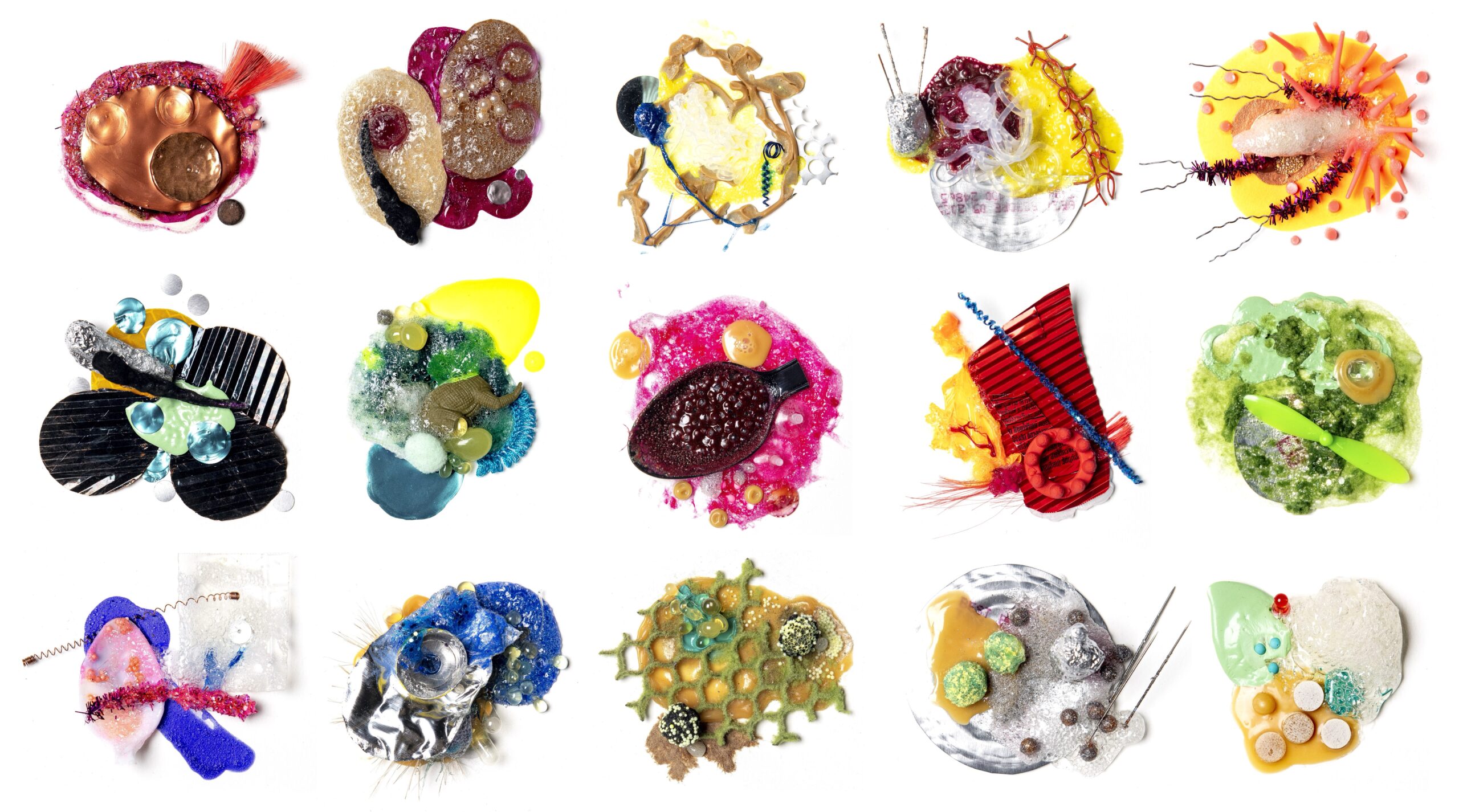
Mahidol University International College
Carol Siatras and Supawan Supaneedis
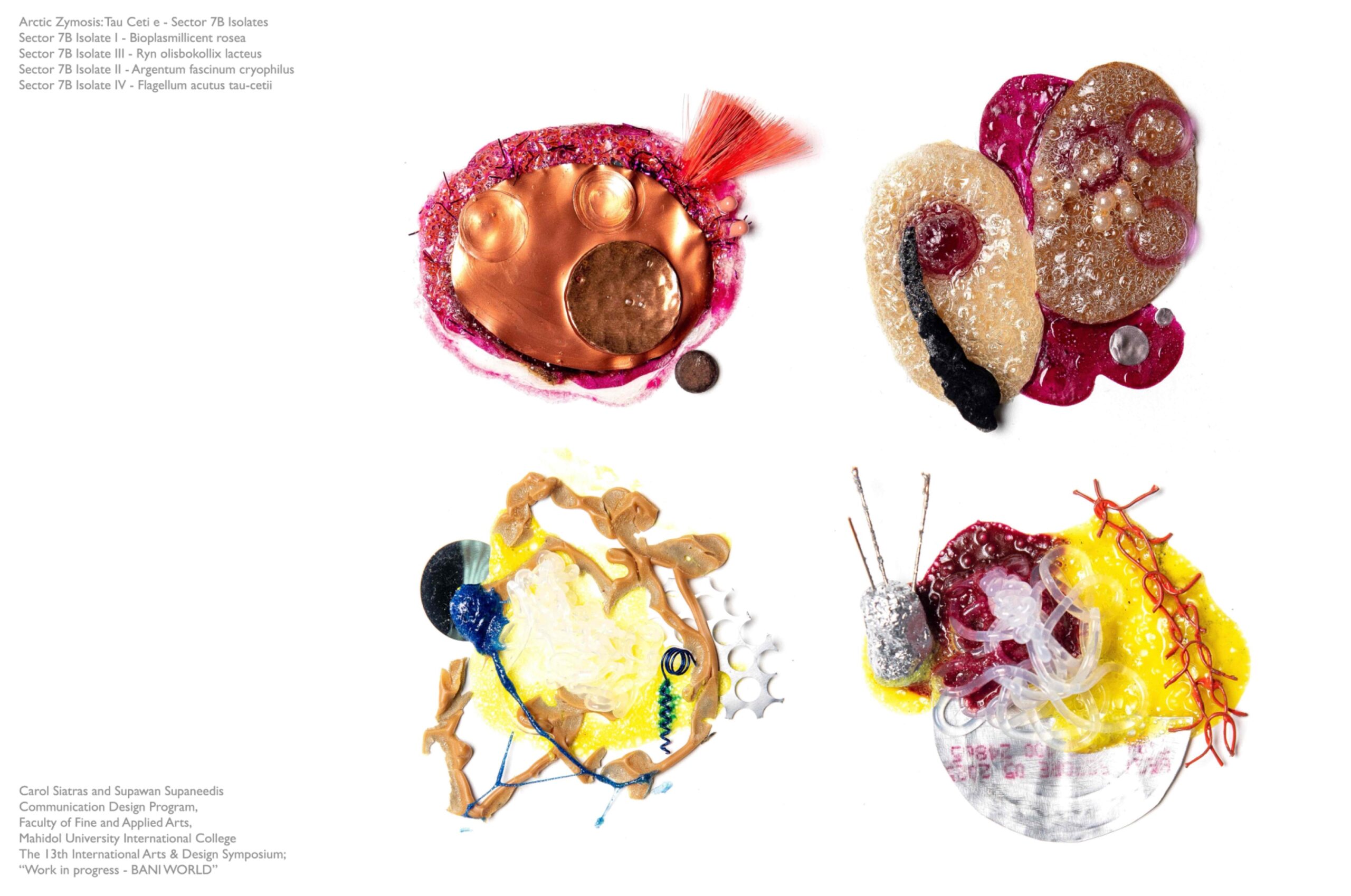
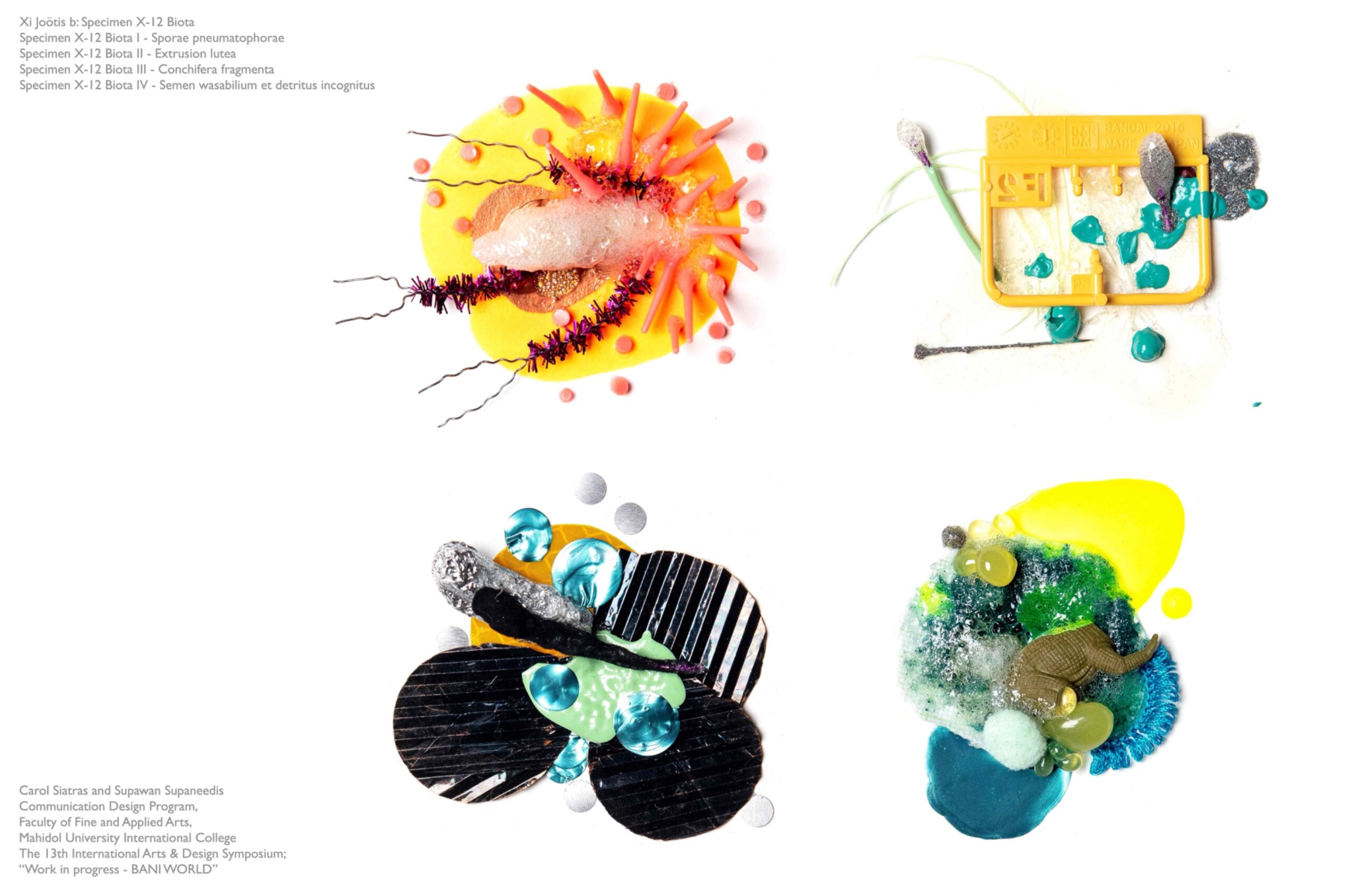
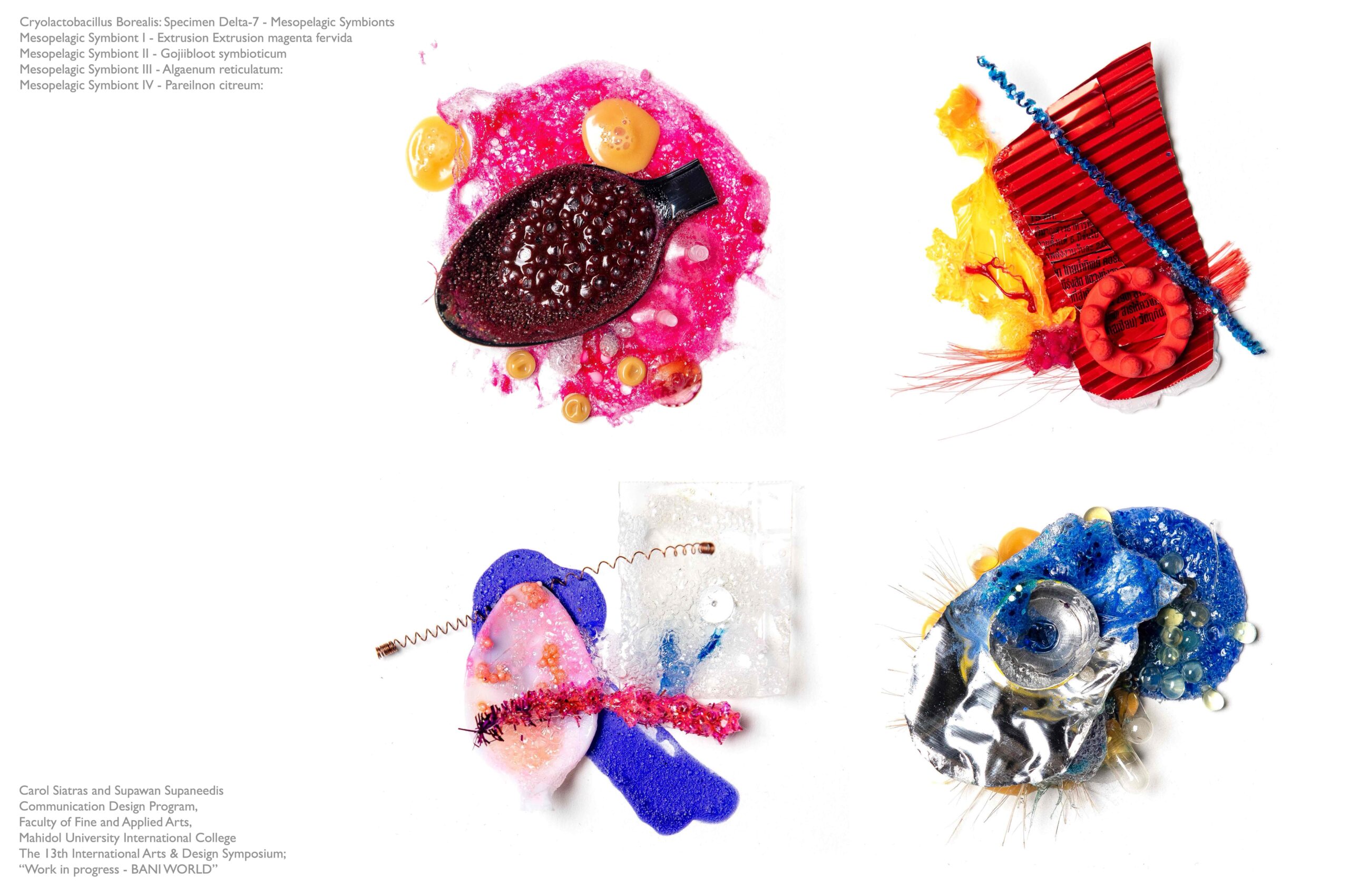
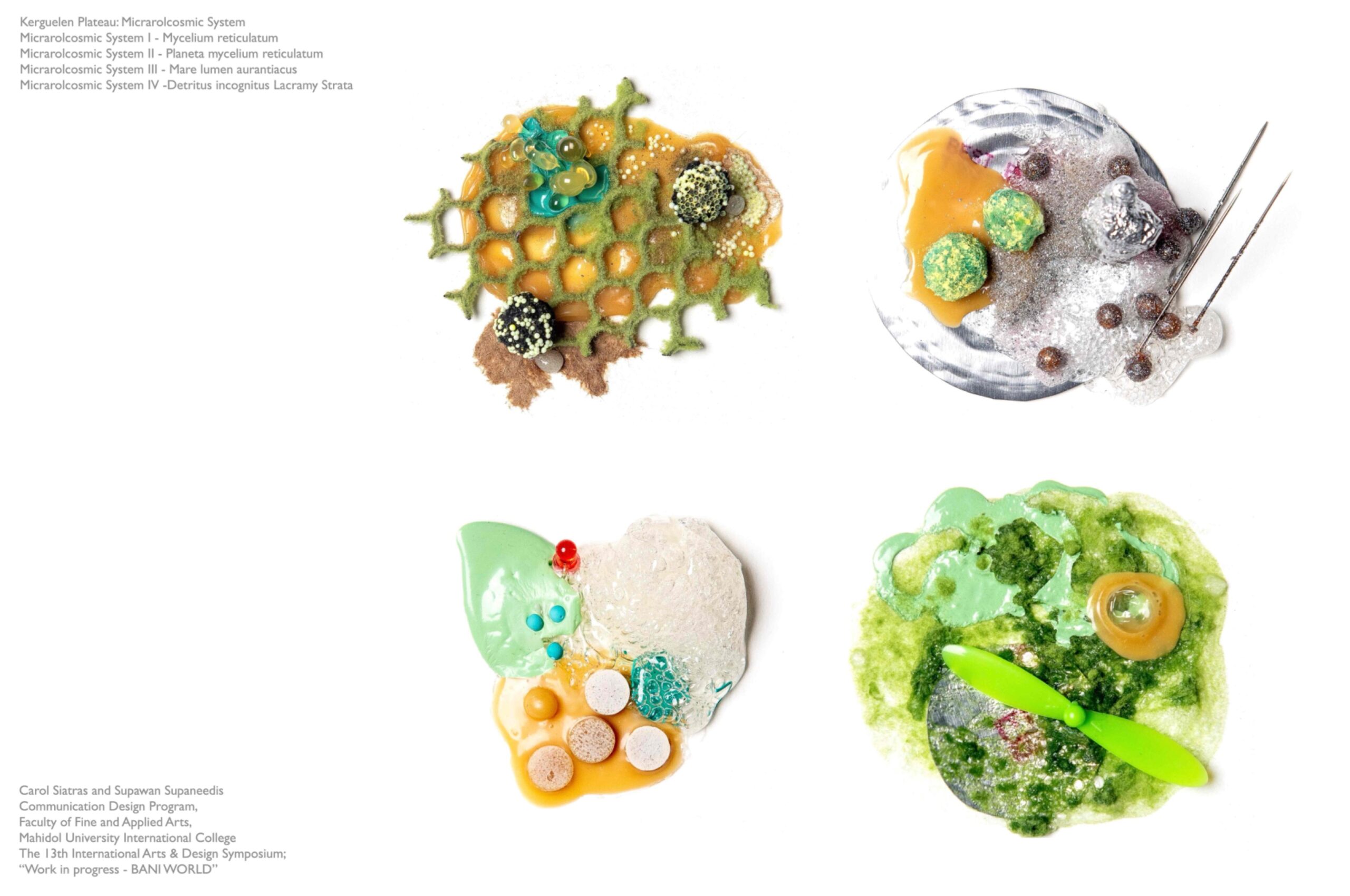
Abstract :
‘Solvent States’ examines the personal through physical experiments (artistic approaches), while channelling the collective: cultural anxiety, absurd obsessions, and crushing blows; environmental devastations, geopolitical crises, and AI’s looming influence. Cascio’s BANI model (2020) tries to articulate the ongoing chaos of the post-pandemic period. Compared to the 80’s VACU model, the overlapping similarities suggest residues of generational trauma, which have been growing larger and more aggressive with time.
This collaborative studio/thought experiment comprises four sets of four biomorphic, mixed-media assemblages. Physically, each blob is an accumulation of found materials bound together with different adhesive substances. The compositions imagine scientific samples, such as microscopic blooms growing in the gel of a Petri dish. Psychically, they reflect a desire to escape to another, imaginary place to reconnect with lost loved ones now ‘solvent’ in the cosmos.
Meanwhile, the study examines popular media (that may serve as both a record of public consciousness and therapy), starting with The Blob (1958). This mid-century precursor to so many sci-fi invasions represented the mass anxiety over impending cultural shifts in the form of a shapeless red goo from outer space. Revisiting The Blob almost 70 years later (with clarity of hindsight) helps draw a relationship to the contemporary BANI world, and the former model seems gentle and naive by comparison. (If only we faced a goopy-gloppy intruder united as one village, if only the antidote was simply chilling (out), if only we could air-drop all the threats to the arctic with confidence that they would stay flash-frozen, neutralized forever. In a pre-BANI world, it would all be enough…)
Researching, we peer into tiny samples of our constant anxiety: What’s out there? What’s coming next? What unformed threat do we lack the tools to contain? Perhaps more disasters in a (Wuhan-esque) lab, like the zombie-creating virus of Last Man on Earth (1964). Or experiments on beauty and security such as those that turned out in Frankenstein (1931), or the recent feministic imaginations of Poor Things (2023) and The Substance (2024). Eventually, the sensual human is basically ‘glob of goo’, a fluid-unstructured micro-cosmic colony of wandering anxieties.
Objectives :
Primarily, ‘Solvent States’ aims to visually and conceptually explore the contemporary BANI world, capturing its pervasive sense of chaos and societal anxiety. Inspired by the parallels between the current climate and representations of scientific monstrous pastiches found in cinematic cultural artifacts, using assemblages of found materials to translate the abstract and overwhelming nature of our reality into tangible forms. Envisioned as extraterrestrial or sub-marine specimens, each assemblage encapsulates the cosmic forces and intimate details that define our existential instability, reflecting a collective unease regarding bodily autonomy, scientific hubris, and the precarious nature of existence.
Simultaneously, the project serves as a personal exploration and cathartic process, utilizing artistic experimentation to confront the anxieties inherent in the BANI world. Assembling found materials, the project navigates personal psychological landscapes by reflecting on the integrated relationship with AI, where AI-driven insights guide the creation and identification of biomorphic forms as a metaphor for sifting through trauma’s ‘ruin-scape’ in an algorithmic age.
Conceptual Framework :
The project is framed around and across the BANI model, examining its quality of brittleness, anxiety, non-linearity, and incomprehensibility with a counter-attempt grounded in empathy, improvisation, intuition, and resilience, as suggested by Cascio. In an attempt to transcend algorithmic limitations, the project collaborates with an AI large language model in creating an experimental dialogue on cognitive offloading and psychology in technology.
The assemblages were heavily inspired by cultural artifacts, particularly cinematic representations of scientific monstrous entities in popular media such as The Blob (1958), and its feminine parallel, Elisasue, from The Substance (2024). Similar to a comparison between the original Frankenstein (1931), and the reimagined Poor Things (2023). These blobs examine the interplay between the feminine and masculine archetypes, but instead of the erected robotic AI domination, it is the non-mechanical, unstructured, illogical, organic, fleshy forms that represent the invasive force of collective anxiety, joining a discussion in the concept of the Monstrous-Feminine introduced by Creed (1993).
Naturally, the project embraced the intuitional and emotional form of biomorphism, in representing the raw life source that is spontaneous and irrational. Doing so, it employed techniques of gleaning and seaming non-traditional materials and found objects into amorphous forms. This echoes the practices of prominent female artists like Judy Pfaff, Sarah Sze, Eva Hesse, and Louise Bourgeois, and continues the conversation surrounding abjection and bodily autonomy.
Process / Methodology :
The project’s began with an analysis of Cascio’s BANI model, delving into its implications for contemporary society. Firstly, a personal reflection, on individual experiences and emotional responses to subjective traumas and the anxieties of current reality. Then expanded see how these anxieties manifest collectively. Cinematic references were investigated as representations of the mass conscious, specifically with feminist film theories. The exploration helps the project pin how anxieties of different generations overlap within personal and public spheres.
It then experiments on potential materials and forms. Imagining an organic sensibility, reminiscent of the shapeless, invasive entities of early sci-fi, that is amorphous or biomorphic. The project attempts to exercise artistic intuition and improvisation in assembling found objects together with different adhesives. Observing and experimenting on choices of colors, textures, and surfaces that the combination may offer.
Eventually, the process evolved to include a collaborative dialogue with the Gemini large language model AI. Focused on imagining the assemblages as specimens collected from environments inaccessible to human observation, such as deep-sea locations and interstellar outer space. While synthesizing personal traumas and anxiety to popular media over the interaction with AI. To challenge the algorithmic code and personalize the works, whimsical and fantastical names were generated via this collaboration, along with identification numbers, mimicking the cataloging of scientific archival specimens.
Techniques and Materials :
Materials for the project were sourced from extremes- from tiny crumbs of studio cast-offs to products displayed on LED-lit market shelves. They include water and solvent-based glues, art and craft supplies (mineral pigments, flocking powders), stationery supplies, cosmetics, and bespoke handmade details. It was a scavenging attempt, a foraging and gleaning for possibilities in making the familiar strange.
Techniques in building the mixed-media biomorphic compositions include pouring, layering, injecting, heating, emulsifying found materials together. Experimenting and imagining the common objects into the unidentifiable, otherworldly compositions. Seeking to create symbiotic relationships to evolve between the materials in a weirdly balanced micro-ecosystem.
Result / Conclusion :
In an attempt to examine contemporary anxieties, the project adopted an experimental artistic/conceptual approach, engaging in a dialogue with the AI large language model, while prioritizing improvisation and intuitive creation. This process resulted in a series of low-relief, biomorphic mixed media assemblages, each approximately 8×8 cm. These ‘scientific’ samples feature brightly colored, irregular organic forms, with textural details of glossy surfaces and metallic references, reminiscent of a otherworldly landscapes or bio-samples. The layered drips and drops invite close inspection, yet may evoke a sense of repulsion. As imaginary biological artifacts, they present a surface metamorphosis or degradation (grotesque irregularities that on a physical body could perhaps be pimple, rash, pus, mole, wart…) contained as imaginary protoplasm, where they can be observed (safely?) within a laboratory. Ultimately, this project serves as a search for ideas, inspiration and catharsis amidst the overwhelming current climate of chaos.
References :
1. Cascio, J. (2020). Facing the Age of Chaos, Distinguished Fellow, Institute for the Future.
2. Creed, B. (1993). The monstrous-feminine: Film, feminism, psychoanalysis. Routledge.
3. Fargeat, C. (Director). (2024). The substance [Film]. Working Title Films; Blacksmith, A Good Story.
4. Higgie, J. (2021). The Tate Etc. Guide to… Biomorphism. Tate Etc, (52). https://www.tate.org.uk/tate-etc/issue-52-summer-2021/guide-biomorphism-jennifer-higgie
5. Lanthimos, Y. (Director). (2023). Poor things [Film]. Searchlight Pictures.
6. Ragona, U., & Salkow, S. (Directors). (1964). The last man on earth [Film]. Associated Producers; Produzioni La Regina.
7. Rouvrais, S., Gaultier Le Bris, S., & Stewart, M. (2018, July). Engineering students ready for a VUCA world? A design based research on decisionship. In Proceedings of the 14th International CDIO Conference, KIT, Kanazawa, Japan (pp. 872–881).
8. Showalter, E. (2007). Lumps, bumps, bulbs, bubbles, bulges, slits, turds, coils, craters, wrinkles and holes. Tate Etc, (11). https://www.tate.org.uk/tate-etc/issue-11-autumn-2007/lumps-bumps-bulbs-bubbles-bulges-slits-turds-coils-craters-wrinkles.
9. Yeaworth, I. S. (Director). (1958). The blob [Film]. Tonylyn Productions Inc; Valley Forge Films; Fairview Productions.
10. Whale, J. (Director). (1931). Frankenstein [Film]. Universal Pictures.